Wiring diagrams in a private house: rules and design errors + nuances of electrical wiring
The power supply scheme of a private house is a lot of ordered cables, wires, protective devices. The correct selection of parameters, characteristics of circuit elements ensures the safety and comfort of property owners.
If the circuit is designed correctly, taking into account the requirements of the PUE and other regulatory documents, there is nothing to be afraid of - the rooms will always have light, heat, and electrical appliances will not break due to power surges or short circuits in the network. Therefore, the design of electricians should be given special attention.
We offer to understand all the intricacies of this process. The article outlines the general requirements for the design of the power grid, provides practical tips for choosing wires, and also describes in detail typical wiring diagrams for electricians.
In addition, we have prepared a review of common mistakes, the account of which will help to avoid shortcomings in the design and installation of power supply networks.
The content of the article:
General rules for the design of the power grid
When there were few electrical appliances, and several light bulbs for 40-60 W were enough for lighting, a primitive scheme was drawn up for the device of the power supply system, including several switches and sockets.
Now, with the advent of a large number of volatile household appliances, the circuit is necessarily differentiated into group lines protected by circuit breakers and other devices.
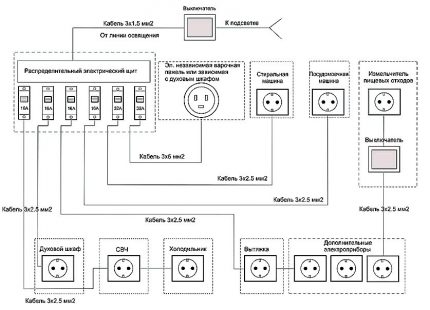
If you consider all the nuances of the location of the wiring in a private house, taking into account the use of copper wire, it will last at least 20 years. Usually, a diagram is made together with the design of a new house or before a major renovation.
You should start by indicating the installation locations of elements such as:
- sockets;
- circuit breakers;
- junction boxes;
- lighting devices;
- powerful household appliances;
- electrical panel.
At the same stage, you should decide on the method of laying the cables - open or closed. In houses with plastered walls, the closed method is usually used, with wooden - the open method.
Whatever scheme you use, there are a number of rules from which you can not deviate. They are spelled out in regulatory documents, and their effectiveness has been proven for decades.
Here are a few important axioms of wiring, which will be required for drawing up a diagram:
In addition to the rules, personal comfort should be considered. For example, a double bed usually has two outlets installed - one on each side.
Switches are placed at a height of 80-90 cm from the floor. In large halls, corridors, rooms install breakers.
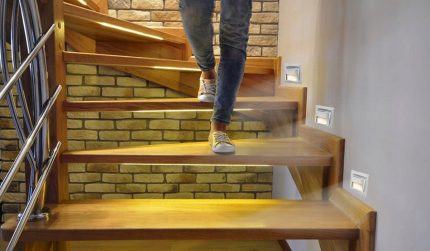
Be sure to ground all metal outlets and objects connected to power lines. For grounding in electrical installations, the third core of the cable is used - a wire in yellow-green insulation.
Guidelines for choosing wires
In houses made of bricks, aerated concrete blocks, cinder blocks, interior decoration of the walls is necessary, which means that they use the hidden method for laying wires.
To provide additional protection, and in case of repair, quickly replace the cable, it is placed in corrugated sleeve non-combustible polymer.

To correctly pick up the wire cross section, specialists make calculations related to the determination of the load.
However, based on standard designs and years of experience, qualified electricians adhere to the following parameters:
- lighting circuits - 3 * 1.5 mm² or 3 * 2 mm²;
- outlet groups - 3 * 2.5 mm²;
- electric stove / oven - 3 * 4 mm²;
- air conditioning - 3 * 2.5 mm², for appliances devices more powerful than 5 kW - 3 * 4 mm²;
- heating boilers - 3 * 4 mm² or more (according to the manufacturer's recommendations).
The optimal cable type is three-core copper: VVGng, ShVVPng. It is impossible to use wires with a cross section less than the specified, since they will not correspond to the load and begin to melt, creating a dangerous situation.
Analysis of wiring diagrams
Consider a few typical schemes that are used in construction or overhaul. All options are combined by the presence of a protective group: by dividing the electrical wiring into circuits, each of which is connected to a separate machine.
Option # 1 - a general scheme-plan for the whole house
This is not a wiring diagram, but a listing of all electrical devices that are planned to be located in the house. Using it you can calculate how many machines and RCD, count the total number of power lines leading to the shield.
Here you must specify the type of mains in order to choose the right cable. For a 3-phase network, a 5-wire cable is taken, for a 1-phase network, a 3-wire cable.
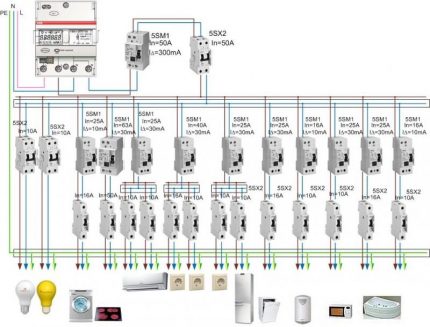
The switchboard is located in a separate room inside the house, in the corridor, in a nearby garage. They also install voltage stabilizers and a backup generator, which supplies the house with electricity during periods of disconnection of the centralized line.
For the convenience of servicing a two- or three-story mansion on each floor, also mount an electric panel. All switchboards are connected to the input cable - a copper wire with a cross section of 15-35 mm².

If in a separate room it is planned to place several lamps and sockets, then at the entrance you need to mount junction box. It connects the input cable to the lighting line and the outlet group.
Option # 2 - sample wiring diagram
To draw a wiring diagram, you need to take a house plan and mark on it the installation location of electrical devices.
This document becomes the basis for making an estimate - it is easy to calculate not only the number of switches, sockets and additional materials, but also to calculate the footage of wires.
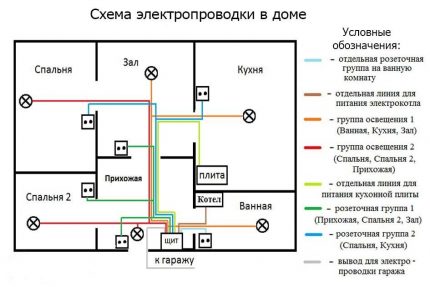
Be sure to indicate the point of entry of the power line into the house and the installation site of the electrical panel. Then, on separate lines, distribution boxes, electrical installations, lighting devices should be noted.
High power devices must also be labeled as they are powered by individual lines.
If farm buildings are connected to the building - a bathhouse, a garage, a workshop - this should also be reflected in the diagram, as it is part of the electrical wiring in a particular private house.
For hand-drawn schemes, there are no special symbols, the main thing is that the owner of the house and the installers understand what is behind each symbol. However better to use common wiring diagramsto subsequently figure out the project yourself.
Option # 3 - a technical solution for a small house
All plans and schemes are similar, since they are built on the same principle, however, they can differ in the number of installed outlets and light circuits, and therefore, in the number of protective devices connected to them.
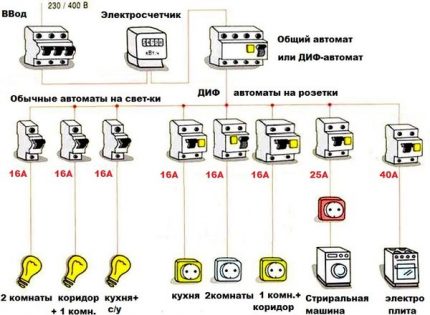
An input switch is installed in front of the network, which, if necessary, can turn off the entire house and turn off the meter. Then follows a counter, and after it - protective groups.
For powerful units, such as a heating boiler or a washing machine, machines are installed at 25-40 A. Wire cross section should also be increased to 3.5-5 mm².
Using such a scheme, you can not calculate the footage of wires, but the number of sockets, distribution boxes, switches, RCDs, automatic machines is easy to calculate.
Option # 4 - wiring diagram for the basement / garage
Often the basement of a private house becomes a utility room where they install a washing machine and equip a dryer, a cellar for storing crops or even a warm garage. It is much more convenient when such a room is fully equipped with sockets and lamps.
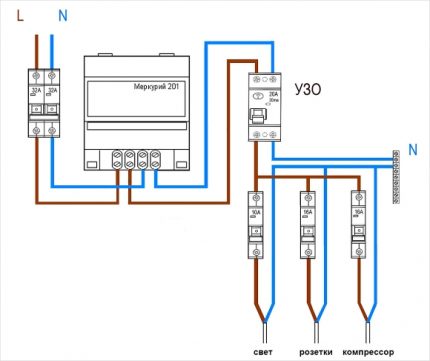
If you do not take the meter into account, the input circuit breakers, grounding bus, 20 A RCD, three circuit breakers will remain on the switchboard: on the lighting line, for outlets and for the compressor. Additional powerful equipment also needs automatic protection.
Option # 5 - kitchen wiring principles
Scheme electricians for the kitchen in a private house it does not practically differ from a similar scheme for a city apartment.
Its feature is a large number of connected electrical appliances, therefore, it will be necessary to allocate several power lines with separate circuit breakers.
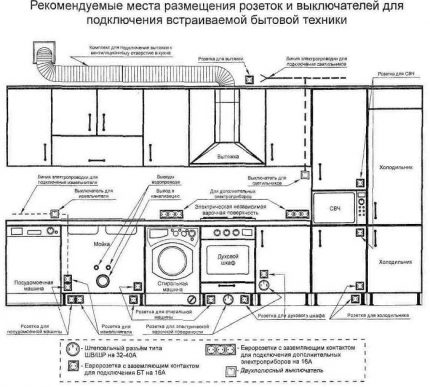
When drawing up a vertically oriented diagram, it is necessary to display a furniture set on paper with the arrangement of all the equipment.
Mesh-free connections, for example, at the oven, are made under the countertop, near the wall, while sockets for the toaster, electric kettle, multicooker, combine are better to take out over the desktop.
Small appliances are easier to unplug if the wiring device is at hand. Outlets mounted near the sink must have degree of protection from IP44 or higher.
Overview of Common Design Errors
Deficiencies in the scheme or work planning entail installation errors, and this threatens with disturbances in the functioning of the power supply network. The result may be the failure of expensive equipment, and even worse - an electrical injury to one of the tenants.
What mistakes should be avoided:
- use low-quality products without labeling and certification;
- make one-to-one settlements - any technical products and materials must be purchased with a margin;
- lay in the project the installation of conventional outlets for connecting cooking surfaces, boilers, heat guns;
- in wooden houses to plan the use of closed wiring - more complex and subject to the list of requirements of the EMP;
- to design switching in one junction box of low-voltage and powerful power wires;
- to plan the connection of wires dangerous for further maintenance and operation of twists; the best option is ready-made terminals;
- make chains of aluminum and copper wires, and also use aluminum wiring.
Some errors relate to incorrect calculations. For example, the cable gates with a closed installation method should be laid to a depth of 2-2.5 cm, not less.
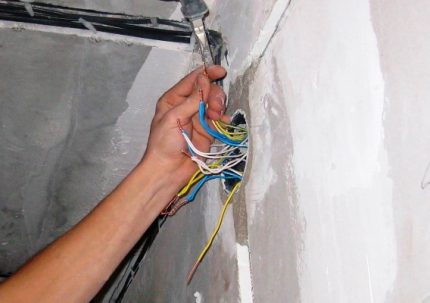
Do not connect the grounding of outlets using a cable, grounding on cast-iron sewer or steel gas pipes.
If you do not know how to properly conduct the electrical wiring in the house, contact the design organization. Specialists will go to the site and draw up a wiring diagram, based on the specific installation conditions.
Conclusions and useful video on the topic
Analysis of the floor scheme:
Rules for wiring diagrams:
Description of the circuit diagram of the switchboard:
Responsibility and risks for "initiative" in the preparation of the project fall on the shoulders of the owner of the house. If you do not have the appropriate education and experience, we recommend ordering documents from an organization that is engaged in professional development of power supply projects.
Do you have personal experience in designing and wiring electricians in a private house? Want to share your knowledge or ask questions about the topic? Please leave comments and participate in discussions - the feedback form is located below.

 Converting Amperes to Watts: rules and practical examples of the conversion of voltage and current units
Converting Amperes to Watts: rules and practical examples of the conversion of voltage and current units  Conventions in electrical circuits: decoding graphics and alphanumeric characters
Conventions in electrical circuits: decoding graphics and alphanumeric characters  How to calculate power, current and voltage: principles and examples of calculation for domestic conditions
How to calculate power, current and voltage: principles and examples of calculation for domestic conditions  How much does it cost to connect gas to a private house: the price of organizing gas supply
How much does it cost to connect gas to a private house: the price of organizing gas supply  The best washing machines with dryer: model rating and customer tips
The best washing machines with dryer: model rating and customer tips  What is the color temperature of light and the nuances of choosing the temperature of the lamps to suit your needs
What is the color temperature of light and the nuances of choosing the temperature of the lamps to suit your needs  Replacement of a geyser in an apartment: replacement paperwork + basic norms and requirements
Replacement of a geyser in an apartment: replacement paperwork + basic norms and requirements
The branched wiring system, the more so in a hidden way behind a drywall partition, has its drawbacks. The main one is that over time, the cable, even a well-fixed one, can sag. I believe that you should always use a corrugated pipe when wiring an electrician and be sure to photograph the work of conducting an electrician. And you also need to make schemes for residents of an apartment or house. If you forget about it, then when you try to nail a nail, you can get an electric shock.
Anton, well, no one says that the pipe is forbidden to use, or that you do not need to give the tenants the scheme. This is clearly a minus for the ears. The cable is unlikely to sag just like that, except for a very extensive time frame. But the pipe will not save from electric shock, but I’m sure that in any case the resident will have a circuit, otherwise it just makes no sense. And the alternatives for this method will also be not enough.
Did the author decide to bust the readers? Why drag a conductive 21A wire to a 16A socket? Why wire lighting devices more than 1kv. mm? Where did you come across a washing machine more powerful than 2 kW in everyday life, and why in this case, a 25A automatic machine?
Good afternoon, Vitaliy.
I will borrow an intermediate position between the author and you.
The question of how much to "drag" on lighting devices, other loads is decided by the project. In modern multi-storey cottages, the “lighting device” can concentrate a considerable load - with ordinary apartments, of course, there are no questions.
Sometimes the author’s terminology is confusing.For example, "lighting contours - 3 * 1.5 mm² or 3 * 2 mm²;". Having thought it over, I understood that the main lines are implied - in order not to spread by words, I attached an explanatory diagram below. Agree, there can be impressive sections on highways.
About a 16-amp socket and a 21-amp wire - this can also be. For example, the customer asked to lay reserve squares in order to expand the range of electrical appliances later.
Regarding the power of washing machines. For example, some Samsungs take more than 2 kW.